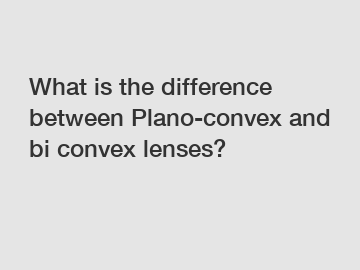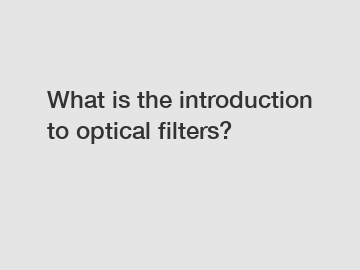What is the difference between Plano-convex and bi convex lenses?
When it comes to optics, lenses play a crucial role in manipulating light for various applications. Two common types of lenses are plano-convex and bi-convex lenses. While they may look similar at first glance, there are key differences between the two that make each one suitable for specific uses. Understanding these differences can help in choosing the right lens for a particular application.
Plano-Convex Lenses.
Plano-convex lenses have one flat (or plano) surface and one convex surface. The convex surface bulges outward, while the plano surface remains flat. This design causes light rays passing through the lens to converge to a focal point on the opposite side of the convex surface. Plano-convex lenses are commonly used in a variety of optical systems, including magnifying glasses, imaging systems, and laser applications.

One of the main advantages of plano-convex lenses is their simplicity and ease of manufacturing. The flat surface of the lens makes it easier to polish and shape, resulting in cost-effective production. Additionally, plano-convex lenses are ideal for collimating diverging light sources or for focusing light to a specific point.
Bi-Convex Lenses.
Bi-convex lenses, on the other hand, have two convex surfaces that bulge outward symmetrically. Light passing through a bi-convex lens converges to a focal point on the opposite side of the lens. Bi-convex lenses are commonly used in applications where a higher degree of magnification or focusing power is required, such as in microscopes, cameras, and projectors.
The symmetrical design of bi-convex lenses allows for minimal optical aberrations, resulting in high image quality and sharp focus. Additionally, the curvature of the surfaces can be optimized to achieve specific magnification or focal length requirements. However, the design of bi-convex lenses can be more complex and expensive to manufacture compared to plano-convex lenses.
Differences between Plano-Convex and Bi-Convex Lenses.
Related links:How to choose the best fused silica optical dome for your purchase stage?
When did the study of optics begin?
The Ultimate Guide to Custom N-BK7 Windows
Exploring the Versatility of Plano Convex Lenses
Exploring Optical Dome-CLZ: Answers to Your Top Google Questions
Are Quality Achromatic Doublet Lenses Worth Investing?
Exploring the Power of Cube Beamsplitters
1. Focal Length: One of the key differences between plano-convex and bi-convex lenses is their focal length. Plano-convex lenses have a fixed focal length determined by the curvature of the convex surface, while bi-convex lenses offer more flexibility in adjusting the focal length by varying the curvature of both surfaces.
2. Aberrations: Bi-convex lenses are designed to minimize optical aberrations, such as spherical aberration and coma, which can distort the image. Plano-convex lenses, while simpler in design, may exhibit more aberrations due to the single convex surface.
3. Magnification: Bi-convex lenses are typically used for applications requiring higher magnification or focusing power, while plano-convex lenses are more suitable for collimation and basic focusing tasks.
Choosing the Right Lens.
When selecting between plano-convex and bi-convex lenses, it is essential to consider the specific requirements of the optical system or application. Factors such as focal length, magnification, image quality, and cost should be taken into account to determine the most suitable lens for the job. By understanding the differences between these two types of lenses, users can make informed decisions to achieve optimal optical performance.
In conclusion, while plano-convex and bi-convex lenses may serve similar functions in optical systems, their distinct designs and characteristics make each one better suited for specific applications. Whether it is for collimation, magnification, or focusing, choosing the right lens is crucial to achieving desired optical outcomes.
Contact us for more information on selecting the right lens for your optical needs.
Are you interested in learning more about custom thin-film coatings , optical glass lenses china, sapphire lenses for sale? Contact us today to secure an expert consultation!
Related links:Comparing Crow Glass vs Achromatic Lenses for Clear Vision
Are Silicon Windows Worth the High Price?
Optical lens processing manufacturers introduce you to germanium meniscus lenses
Biconvex Lens - Definition, Properties, Uses and Applications
What is the introduction of tensile test experiment?
Key Questions to Ask When Choosing Custom Laser Cut Designs
How Ball Lens Optics Improve Your Vision Quality











